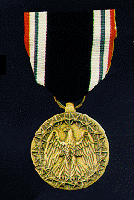

39th Bomb Group (VH)


|
Prisoners
of War |
| blank |
Pages 401-403 cite the source for information (next 3 web pages) is a book "Some Survived" by E. Bartlett Kerr. It is "an account of American POWs in the Pacific. 1941-1945." Algonquin Books of Chapel Hill published it in 1964. NC. 27515-2225. Only a limited part of this excellent book deals with B-29 POWs, Although names and units of those crewman are unknown, it does confirm conclusively that large numbers of 20th Air Force fliers were taken prisoner by the Japanese. Also, from the instances cited, it would indicate that most of them probably did not survive. The accounts by the individuals indicated on the above navigational bar are from pages 404-408 and are comments received in letters from former Prisoners of War to Mr. Laird for "History of the 39th Bomb Group (VH)". Anyone with additional information appropriate for this section is encourage to contact updates@39th.org |
As Manny Lawton points out in his book, "Some Survived," few people know what happened to the 25,000 American soldiers, sailors, airmen and marines who were captured by the Japanese during World War II. Only three out of five survived the barbaric treatment they received during their confinement; many of those that did somehow endure, returned home physically, psychologically and emotionally scarred by months, even years, of imprisonment. The Japanese military tradition believed fanatically that surrender was dishonorable. Therefore, they were totally unprepared to humanely handle the largest number of American prisoners ever taken by a foreign nation. Asian rations were scarce, but the diet of the POWs bordered on starvation. American prisoners were taken to their physical and mental limits. This resulted in overwhelming instances of permanent psychic disorders. They were subjected to gnawing hunger, extremes of heat and cold, unbearable thirst, unlimited torture, boredom, loneliness and never-ending fear. In all ways, the Japanese intention was to completely destroy the bodies, souls and dignity of our Allied prisoners. Practically all POWs suffered from scurvy, pellagra, Bin-bin, malaria, malnutrition and poor vision. Many developed gangrene from untreated wounds. Totally debilitated, they were little more than walking skeletons. And contrary to universally accepted rules in the handling of prisoners, they were often placed in locations subject to the most intense bombings. As a result, an unknown number of prisoners were either killed or severely maimed by bombs falling within prison compounds.
Beginning with the March 1943 B-29 raids, the Japanese had taken captive an increasing number of B-29 flight crews who had survived after enemy flak or fighters brought down their planes.
The Japanese Army had a policy of separating downed American fliers from the other Prisoners of War. Their reason for doing this was that they did not want longtime POWs to learn how badly the war was going for Japan. This did not accomplish its purpose, however, because many of the prisoners had witnessed for themselves the widespread devastation inflicted on Japan's cities. Furthermore, they could sense the disintegrating effect it was having on the people's will to continue the war. After fliers were captured, the Japanese military conducted half-hearted interrogation. There was little they could learn that could lessen the calamitous bombings by our B-29s. It was for this reason that the American Air Force lessened its restrictions on captured airmen. Here-to fore, the prisoner was allowed to give only his name, rank and serial number. But now, there were no limits on information a prisoner could give his captors if it would help him to escape death or torture.
 |
|||||||
6 |
6
|
||||||
Copyright © 2000 - 2025 - 39th.org|39thbombgroup.org

